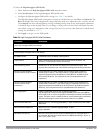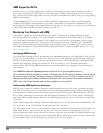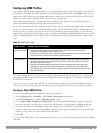
DellPowerConnectW-SeriesArubaOS6.2 | User Guide AdaptiveRadioManagement (ARM) | 346
Chapter 21
Adaptive Radio Management (ARM)
This section describes how to configure the ARM function to automatically select the best channel and transmission
power settings for each AP on your WLAN. After completing the tasks described in the following pages, you can
continue configuring your APs as described in the
Dell PowerConnect W-Series ArubaOS 6.2 User Guide
.
The documentation for this feature includes the following topics:
l "Understanding ARM" on page 346
l "Configuring ARM Profiles" on page 348
l "Assigning an ARM Profile to an AP Group" on page 355
l "Using Multi-Band ARM for 802.11a/802.11g Traffic" on page 356
l "Enabling Band Steering" on page 356
l "Enabling Traffic Shaping" on page 358
l "Enabling Spectrum Load Balancing" on page 359
l "Reusing Channels to Control RX Sensitivity Tuning" on page 360
l "Configuring Non-802.11 for Noise Interference Immunity" on page 360
l "ARM Metrics" on page 361
l "Troubleshooting ARM" on page 362
Understanding ARM
Dell's Adaptive Radio Management (ARM) technology maximizes WLAN performance even in the highest traffic
networks by dynamically and intelligently choosing the best 802.11 channel and transmit power for each Dell AP in
its current RF environment.
Dell’s ARM technology solves wireless networking challenges such as large deployments, dense deployments, and
installations that must support VoIP or mobile users. Deployments with dozens of users per access point can cause
network contention and interference, but ARM dynamically monitors and adjusts the network to ensure that all users
are allowed ready access. ARM provides the best voice call quality with voice-aware spectrum scanning and call
admission control.
With earlier technologies, network administrators would have to perform a site survey at each location to discover
areas of RF coverage and interference, and then manually configure each AP according to the results of this survey.
Static site surveys can help you choose channel and power assignments for APs, but these surveys are often time-
consuming and expensive, and only reflect the state of the network at a single point in time. ARM is more efficient
than static calibration, and, unlike older technologies, it continually monitors and adjusts radio resources to provide
optimal network performance. Automatic power control can adjust AP power settings if adjacent APs are added,
removed, or moved to a new location within the network, minimizing interference with other WLAN networks.
ARM adjusts only the affected APs, so the entire network does not require systemic changes.


















